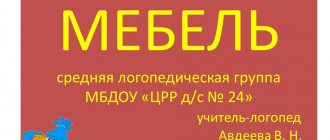Morning exercises as part of the educational process in kindergarten
All parents know the importance of doing physical exercise after waking up. But in modern life it is not always possible to maintain the correct daily routine. Admission of children to kindergarten begins at 7:00, and parents bring many children without exercise and without breakfast. Therefore, the approximate start of a weekday for preschoolers is as follows:
- 6:30–7:00 — get up, morning toilet at home;
- 7:00–8:10 — admission to the kindergarten group;
- 8:10–8:30 — morning exercises;
- 8:30–9:00 – breakfast.
What is charging for? - This is not a riddle at all - To develop strength And not get tired all day.
P. A. Sinyavsky
Morning exercises are designed to invigorate children and provide a positive emotional mood
Children should grow up healthy so that the necessary skills and abilities are easily formed and their abilities are actively developed. A healthy child is receptive to learning, understands the requirements of the teacher, and his natural interest in learning is strengthened. Therefore, exercise is a regular activity in kindergarten. The goals of morning (hygienic) gymnastics in preschool educational institutions are to preserve and strengthen the physical and mental health of preschoolers and create a positive emotional tone.
Doing exercises strengthens both physical and mental health - the child experiences positive emotions
Morning exercises are part of children’s physical activity regimen. It is a set of physical exercises for muscles and joints. Exercises for preschoolers are often supplemented with elements of breathing exercises and finger games. Morning exercises can be combined with hardening techniques. In addition to health-saving functions, exercise plays a significant role in the development of mental processes, communication abilities, and the expansion of cognitive interests. Morning exercises are one of the tools for raising a comprehensively developed personality.
In the process of performing exercises, preschoolers train attentiveness
Interesting fact. During exercise, endorphin is actively produced - the hormone of joy. It is responsible for a good mood and blocks negative emotions.
Table: tasks of morning exercises in different kindergarten groups
| Development area | First and second junior groups (1.5–4 years) | Middle group (4–5 years old) | Senior and preparatory groups (5–7 years old) |
| Physical development |
|
|
|
| Mental development |
|
|
|
| Moral development |
|
|
|
Doing morning exercises helps the body wake up
Types of morning exercises
Complexes of morning exercises are implemented according to general principles:
- accessibility: exercises and games correspond to the physical training of preschool children, explanations and demonstrations are clear;
- efficiency and benefits: exercise develops children, improves their physical condition;
- positivity: preschool children do exercises for a good mood; if the child is not inclined to physical activity (sick, upset), he is not forced to exercise.
For exercise to become a habit among children, it must captivate them and bring joy. To create sustainable motivation for preschoolers to do morning exercises, the teacher selects interesting exercises, conducts classes in a playful way, or uses unusual equipment. Let's take a closer look at what exercises are like in kindergarten.
General developmental gymnastics is a simple set of exercises, not united by any plot, aimed at stimulating motor activity. Performing movements, as a rule, takes place according to poetic texts or to musical accompaniment. Audio exercises are carried out in kindergarten from the first junior group; the melody helps children feel the pace of movements. Morning exercises can be performed with live accompaniment in the music room or using audio recordings.
Video: morning exercises “Pioneer Dawn”
“Pioneer Dawn” was familiar to all children in the USSR. Every morning, the cheerful voice of the announcer on the All-Union radio greeted the Octobrists and Pioneers. Pleasant instrumental music sounded and clear commands for movements were given. Currently, the activities of the pioneer organization are being rethought and reassessed; the movement continues to exist, preserving the time-tested methods of Soviet pedagogy. Classical exercises accompanied by upbeat music are carried out in kindergartens and schools.
Physical and play exercises can be combined by a theme in accordance with the work program. Thematic gymnastics in kindergarten is associated with the natural calendar and holidays: “Autumn”, “Winter”, “Spring”, “February 23”, “March 8”, “Cosmonautics Day”, etc. Songs, melodies, and poetic material are devoted to the general theme , attributes, role masks or caps.
Video: themed morning exercises “Winter” in the middle group
Plot exercises are a set of exercises united by a theme or built on a simple plot. Younger preschoolers love stories and poems about animals; “Bird exercises” and “Exercise about animals” are held with them. For older children, the complexes “Training of future cosmonauts”, “Atty-bats, we are soldiers”, “Sea voyage” are interesting. Exercises in story gymnastics are connected by a fictional story or an educational story: about the habits of animals and birds, about service in the army and navy, about the training of astronauts, etc.
Video: morning exercises “Journey to Murland” for children 3–4 years old
“Journey to Murland” is an excellent example of morning exercises for young children. The teacher prepared a set of exercises together with the music director: during exercises, wonderful rhythmic melodies are heard and songs are sung. The room is decorated with images of cats and plush toys. Mustaches are drawn on the faces of the children and the teacher. The children happily strive to get to a magical land, completing tasks for this purpose, and themselves “reincarnate” into kittens.
Morning exercises on beds and pajama exercises are exercises that are performed immediately after waking up. This type of charging is possible in 24-hour preschool educational institutions and five-day kindergartens, where preschoolers spend the full day, including staying overnight. Pajama gymnastics helps the whole body wake up: tissues and internal organs are actively saturated with oxygen - the muscles and brain become toned. They won’t say about a child doing gymnastics immediately after getting up: “They lifted him up, but they forgot to wake him up.”
Video: gymnastics after sleep in kindergarten
Awakening gymnastics is also carried out in the middle of the day - after a quiet hour. The same sets of exercises for the first and second half of the day are used - aimed at gently awakening the body. As shown in the video, it is correct to perform the exercises while listening to quiet, slow music. You can use audio recordings of natural sounds with instrumental accompaniment (bird songs, sounds of the forest, the sound of rain or sea).
Non-traditional exercises include gymnastic complexes using unusual equipment. These are homemade items from waste material: expanders, sensory mats and tracks, rattles, dumbbells made from plastic bottles. Under the supervision of a physical education instructor, exercises are carried out with elements of aerobics (on step platforms) and the use of sports equipment (mini-trampolines, treadmills).
Video: morning exercises on step platforms in the preparatory group
As we can see, the exercises are carried out by an instructor in the gym. The step platform seems like a simple attribute. But incorrect aerobic exercise technique can lead to excessive stress on the joints and even injuries. To carry out such exercises, consultation with a physical trainer is not enough; constant monitoring of aerobic activity is necessary.




